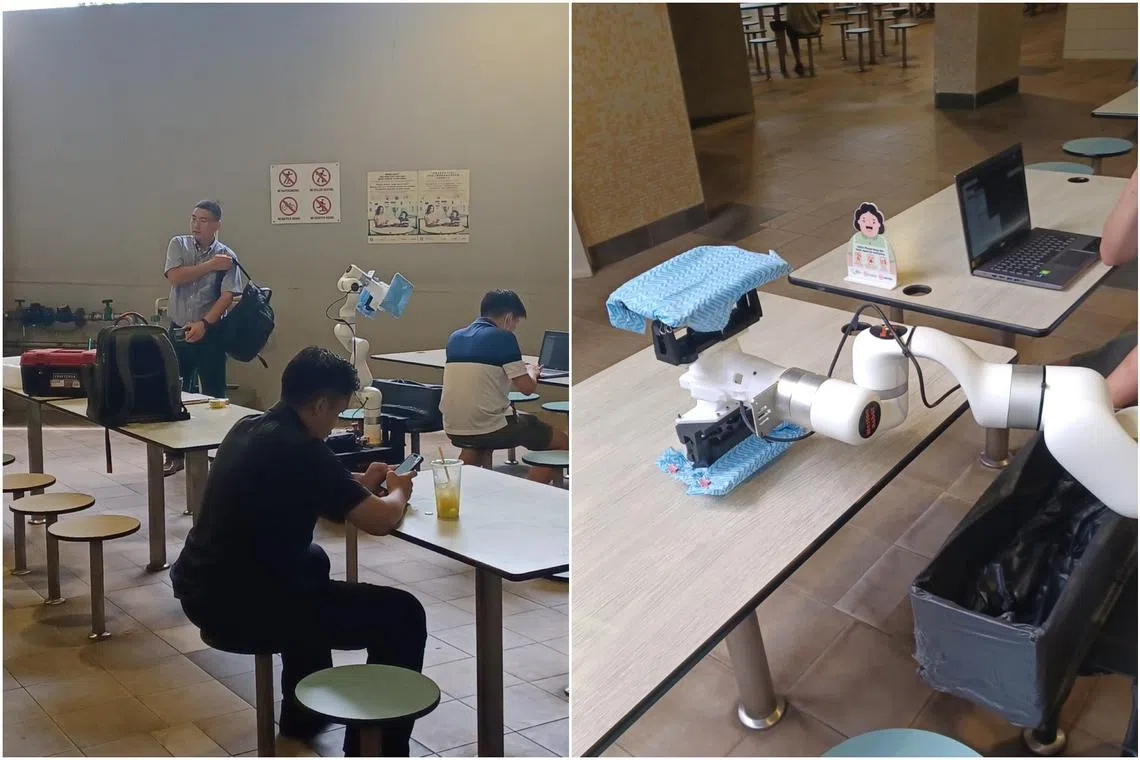NEA exploring table-cleaning robot at hawker centres to support manual labour
Sign up now: Get ST's newsletters delivered to your inbox

A similar table-cleaning robot being tested at Marsiling Mall Hawker Centre in 2022.
PHOTOS: ST READER
Follow topic:
SINGAPORE - Hawker centres may get automated table cleaners under the National Environment Agency’s (NEA) plan to support manual labour.
A two-month trial of a robot will be conducted at a suitable hawker centre and stallholders there will not need to bear any costs of the trial, an NEA spokesman told The Straits Times.
Observers said the robot could help to meet the manpower crunch as the cleaning workforce ages, but its development might be slowed by the still-developing autonomous table-cleaning technology.
In a tender called by NEA on Nov 7, the agency said that while its tray-return policy has drastically reduced the workload on the cleaning workforce, there is a need to supplement manual cleaning labour with automation that can patrol, clean and wipe tables that have been vacated.
Even after the returning of trays was made mandatory in June 2021, cleaners generally must still clean dining tables as well as sort and clear used crockery, cutlery and trays of food remnants at tray-return stations before used items are washed, the NEA spokesman said.
Autonomous table-cleaning robots can support and complement cleaners so that tables are cleaned faster, she added.
According to tender documents, the robot should be able to clean the table in under one minute and navigate from table to table within another minute, leaving unsuitable tables for human cleaners.
If successful, the machine could be one of the earliest mass-produced table-cleaning robots in the world, said observers and robot developers.
Associate Professor Pham Quang Cuong from Nanyang Technological University’s School of Mechanical and Aerospace Engineering said that while the technology for automated floor-cleaning robots is widely commercialised, those that can clean tables appear to still be at an early stage.
In November 2021, for instance, Google disclosed that it had developed a robot that can wipe tables with a squeegee, but to date, the machine is still not mature enough to be commercialised, said Prof Pham.
Cleaning robots that are currently commercially available are used only for routine and repetitive tasks such as cleaning floors, windows and swimming pools, not for dynamic environments, said service robot company Ourglass Robotics’ chief executive William Dai.
Mr Ling Ting Ming, founder and CEO of robotics company Otsaw, said NEA’s robot will need to navigate crowds on top of cleaning crockery.
He said: “Having a robot navigate dynamic groups of humans will be a challenge, especially since hawker centres can get quite crowded and are not built for robot cleaners to move between tables.”
While NEA did not disclose the location of the trial, tender documents said the robot must be able to pass between tables spaced apart like those in Marsiling Mall Hawker Centre.
Hawkers at the centre told ST on Nov 25 that they had previously observed another table-cleaning robot being trialled at the centre, adding that any future robots had to be faster for them to be convinced.
Ms Wei Xia, 46, who was manning the Beef King by Yassin Kampung stall, said: “If it could lower the costs of cleaning that would be good, but when a table-cleaning robot was trialled a few months ago, I felt that humans were faster.”
Freshly Made Hong Kong Style Zhu Chang Fen stallholder Kevin Yong, 60, who noticed that the robot stopped whenever people walked past it, said he was concerned that the machine might stall during peak hours because of human traffic.
Said Mr Yong, who identified himself as the secretary of Marsiling Mall Merchants’ and Hawkers’ Association: “Just one table is going to take donkey’s years.”
The recent tender comes amid a surge in the use of autonomous cleaning robots in the healthcare and hospitality sectors during the Covid-19 pandemic.
Hotel chains such as Hilton, InterContinental and Marriott are using robots for room cleaning and to make room service deliveries, said Professor David Tan, co-director of National University of Singapore’s Centre for Technology, Robotics, Artificial Intelligence and the Law.
He added that in a future where autonomous table-cleaning robots are deployed, organisations will have to determine which parties are responsible for paying compensation if a cleaning robot spills a bowl of hot soup onto a young child.
It should also not come at the cost of vulnerable segments in Singapore, he said.
He said: “In Singapore, the use of cleaning robots may arguably be more efficient or even desirable in the light of the manpower crunch experienced by the food and beverage sector.
“However, one also has to look at the social impact of such accelerated automation, as more vulnerable segments of our local population may be relying on such cleaning jobs as their stable source of income.”
Ourglass Robotics’ Mr Dai said it is more productive and efficient to make robots that can help workers, instead of ones to replace them. He added that many of the elderly workers his company has spoken to have fears that they might be replaced by machines.
He said: “Elderly workers are still better at wiping the table. They are just not strong enough to carry (heavy items) and can’t walk fast enough.
“Pairing up workers with a delivery robot is a good solution. It can turn a cleaner auntie into a robot supervisor or a super-auntie – that would make her feel better.”


